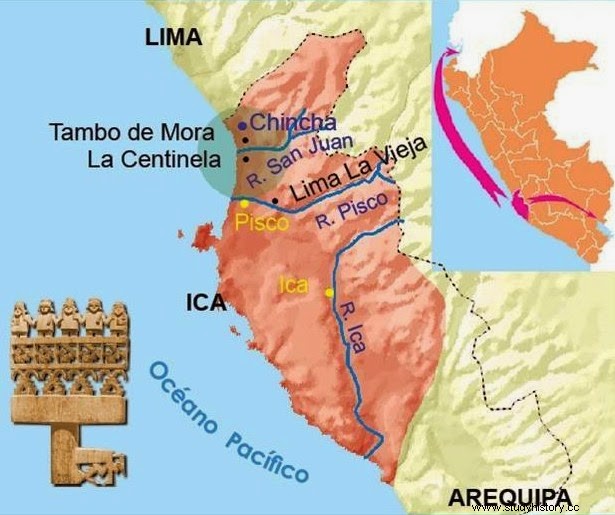 Location map of the Chincha confederationECONOMY Predominated interregional trade consisting of the exchange of products with:1. The southern Andean highlands. The northern coast (now Ecuador)3. The south coast (today Chile)
Location map of the Chincha confederationECONOMY Predominated interregional trade consisting of the exchange of products with:1. The southern Andean highlands. The northern coast (now Ecuador)3. The south coast (today Chile)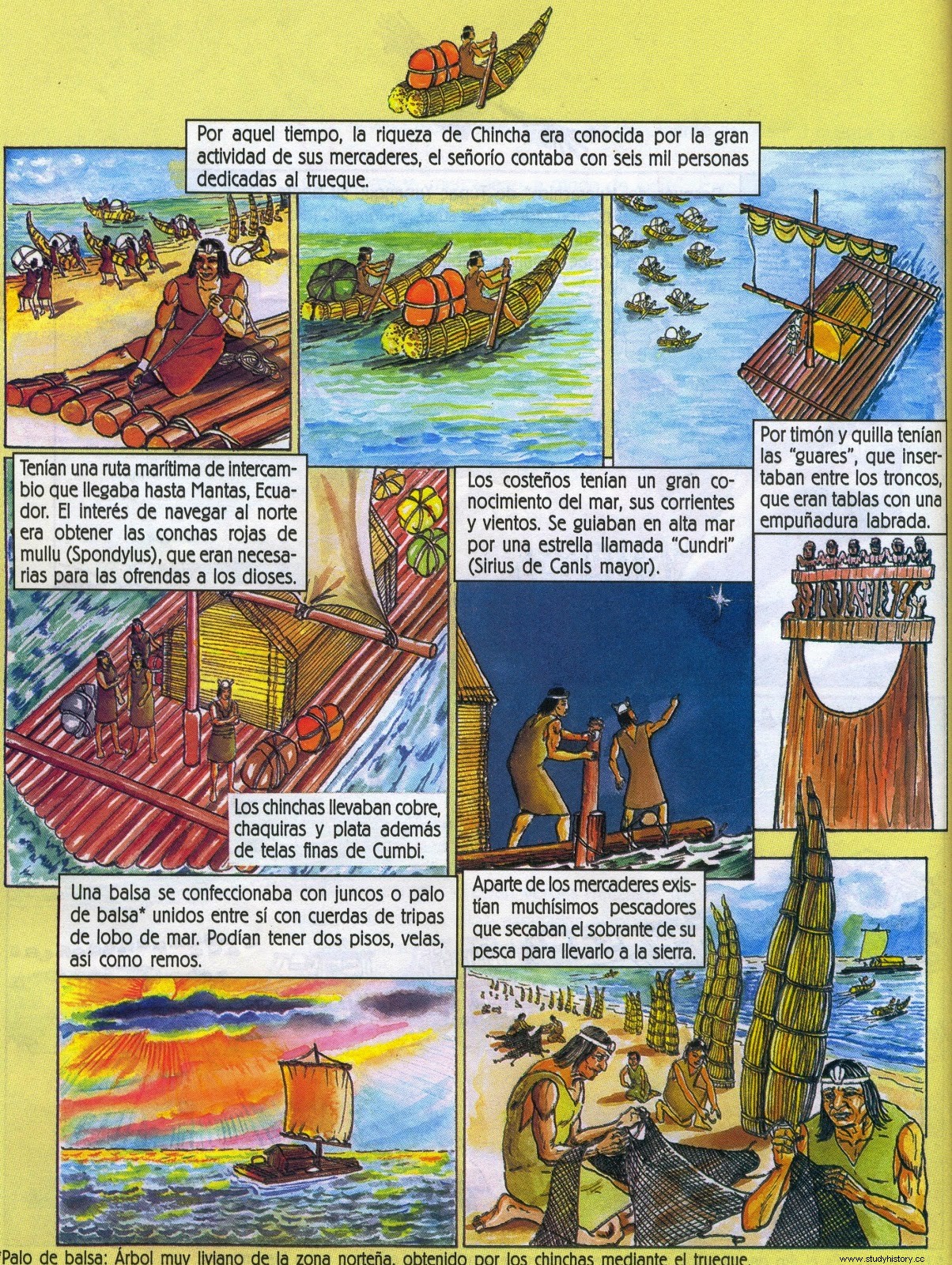 Their main economic activities were agriculture and fishing. The outstanding handicraft production was pottery in a round shape, with a predominance of black and white over red. The natural conditions of the valley indicate a high agricultural productivity, which must have been the basis of the subsistence economy of the Chincha society. The excavations carried out show a high percentage of consumption of corn, fruits and various marine resources, according to Sandweiss. However, the economic activity, which would have had various political implications, seems to have been long-distance exchange, integrating territories that ranged from the Ecuadorian coast to the Collao region in the Peruvian-Bolivian highlands, using boats to link the coast and caravans of llamas to unite the inter-Andean basins. This activity was originally from Chincha and, after the Inca presence in the area, around 1476, it would have been integrated into the economy of the empire and maintained not only the items related to the traffic of goods, but also the status of the rich and powerful lords.
Their main economic activities were agriculture and fishing. The outstanding handicraft production was pottery in a round shape, with a predominance of black and white over red. The natural conditions of the valley indicate a high agricultural productivity, which must have been the basis of the subsistence economy of the Chincha society. The excavations carried out show a high percentage of consumption of corn, fruits and various marine resources, according to Sandweiss. However, the economic activity, which would have had various political implications, seems to have been long-distance exchange, integrating territories that ranged from the Ecuadorian coast to the Collao region in the Peruvian-Bolivian highlands, using boats to link the coast and caravans of llamas to unite the inter-Andean basins. This activity was originally from Chincha and, after the Inca presence in the area, around 1476, it would have been integrated into the economy of the empire and maintained not only the items related to the traffic of goods, but also the status of the rich and powerful lords. The flow of goods transported by the Chinchanos is recorded in a document from the early colonial period, studied by María Rostworowski, which alludes to a large population differentiated by the activity carried out:merchants, fishermen, farmers, artisans and service people. The merchants trafficked with the mullu (Spondylus shell, considered a symbol and food of the gods) and emeralds brought from Ecuadorian territory. From Collao they transported copper and wool, and from Chincha dry fish. This information has not been proven archaeologically yet, but in fact the document suggests that it was a rich and powerful regional political entity, of transcendental importance in the Inka economy, whose ruler, "the Lord of Chincha", was the object of similar attention. to those of the Inca. An example of his participation in the protocol is his presence, carried in a litter like Atahualpa, on the fateful afternoon of November 16, 1532, when Francisco Pizarro took the Inca plaza of Cajamarca.
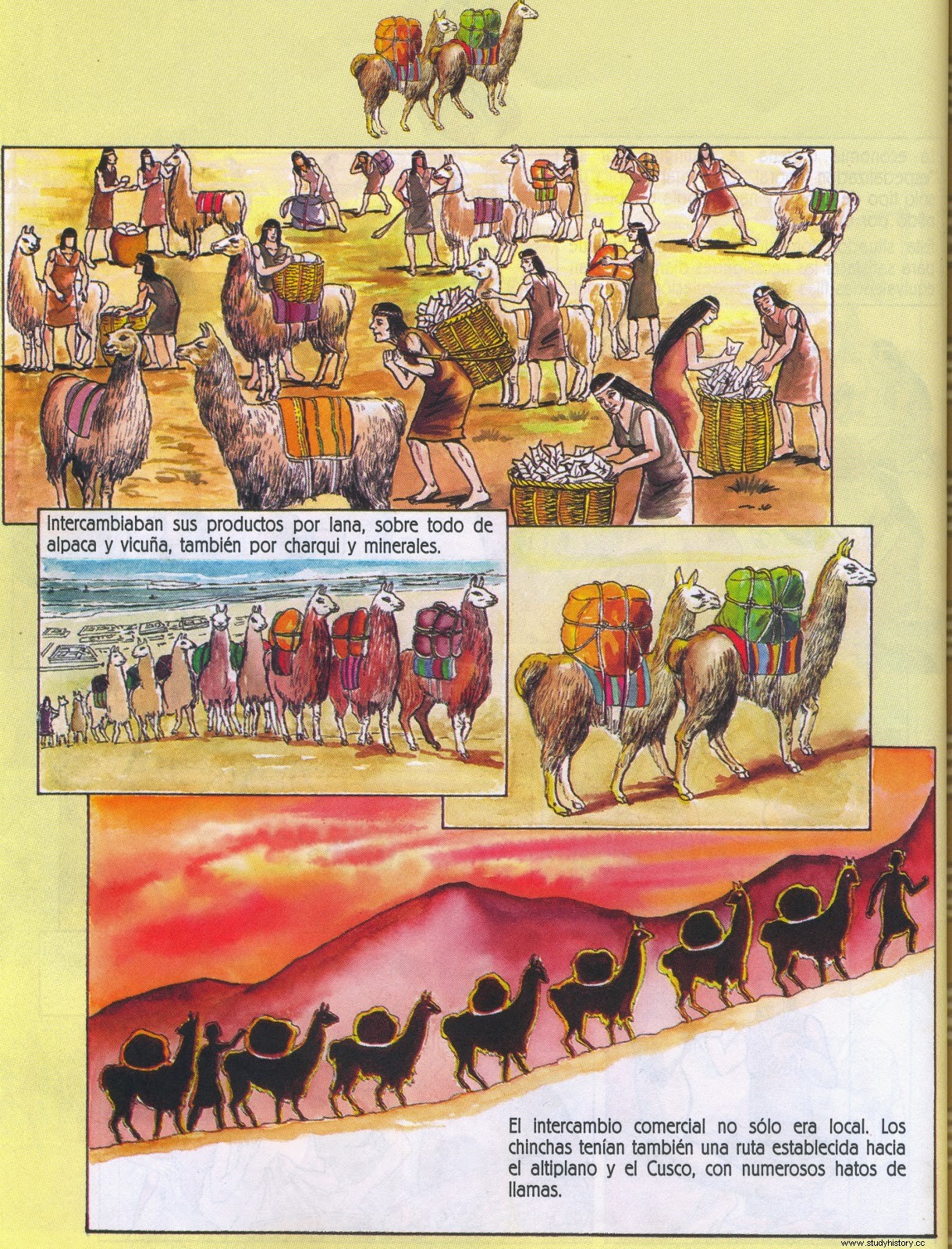 Fishermen had small boats or rafts made of reeds. They used nets, baskets, hooks, harpoons, etc. In addition, they had the Challhua Hapi (fishermen) and the Challhua Camayoc (fish merchants) as specialists.
Fishermen had small boats or rafts made of reeds. They used nets, baskets, hooks, harpoons, etc. In addition, they had the Challhua Hapi (fishermen) and the Challhua Camayoc (fish merchants) as specialists.In Chincha there would be "at least six thousand merchants (...). It was a trade based on barter and also of the currency, which consisted of shells and pieces of copper with which they carried most of their transactions. All of which was facilitated by the use of scales, weights and measures (...). The scales were made of wood and plates adopted artistic forms, for example fish, and were held with strings" (Espinoza, Waldemar -1983). Fish merchants arrived in Cusco and the Callao plateau, in the south and in the north up to the from Ecuador. The transport was done by means of rafts, in the sea and on the back of a llama in the land area. The products that the chinchas marketed were:shells, chaquira, emerald, gold, copper, wool, jerky, chuño, dried fish, cochayuyo, mate, etc. The main object of their barter was the red mullu (spondylus) shells that they obtained on the second route that they undertook by sea and on rafts with triangular sails to Manta and Puerto Viejo, in present-day Ecuador. The peasants cultivated mainly corn and other plants, while the fishermen went out to sea in turns or in mita, with their rafts and nets and, when they were on land, they were fond of drinking and dancing. They lived on a long street facing the sea.
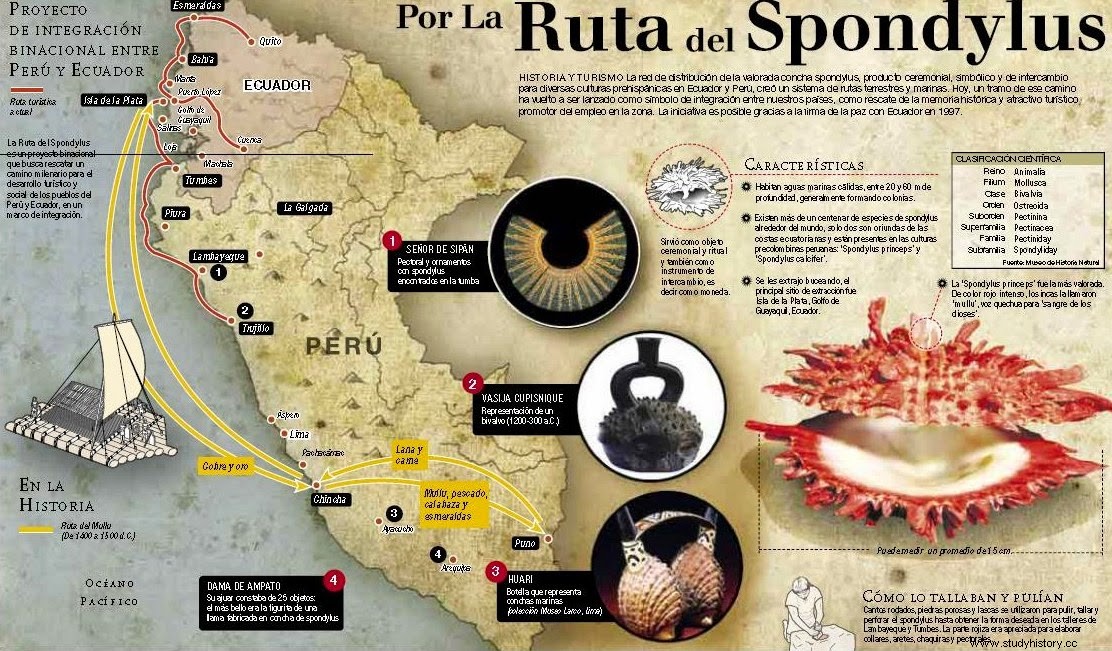 The Chinchanos integrated vast territories that ranged from Ecuador to the north to Collao in the Bolivian-Peruvian highlands. Map of long-distance exchange routes from Chincha. (Based on Rostworowski 1977).
The Chinchanos integrated vast territories that ranged from Ecuador to the north to Collao in the Bolivian-Peruvian highlands. Map of long-distance exchange routes from Chincha. (Based on Rostworowski 1977). 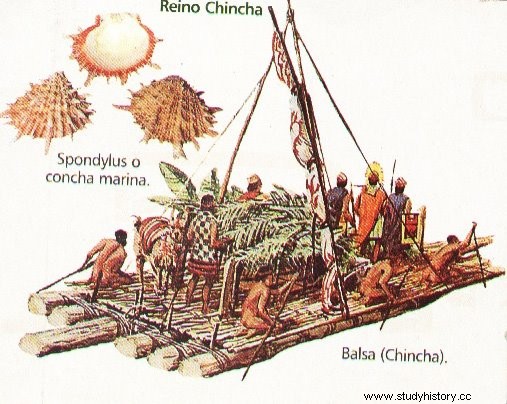 Boat used by the Chinchas. SOCIAL AND POLITICAL ORGANIZATION The chinchas constituted a class society where a third of the population was dedicated to fishing activity. They were characterized by having a commercial economy (Talascocratic), for which it is said that the State was commercial theocratic. The Chincha culture or Kingdom was a lordship governed by a Chinchay Cápac (Chincha governor). They were small manors grouped by a central government. It had a theocratic and militaristic state and government. It was a society with a marked social stratification - slave with a dominant class (priestly-military bureaucracy) and a dominated class (peasants, merchants and fishermen). The priests occupied a privileged position within the dominant class, that is, they They considered intermediaries between the gods and the people. He was followed by military leaders and great merchants. They formed the dominated social sector:peasants, fishermen and artisans." The fishermen entertain the goddess urpiwachay bringing him their offerings of fish, and they beg him to propitiate abundant fishing when they go out on their little totora horses to look for their sustenance in the sea. The old coastal fishermen (...) went daily on their rafts to the sea in search of fish, an important part of their diet and sustenance, for them urpiwacha the mother of the fish was sacred" (Espinar La Torre - 1994).
Boat used by the Chinchas. SOCIAL AND POLITICAL ORGANIZATION The chinchas constituted a class society where a third of the population was dedicated to fishing activity. They were characterized by having a commercial economy (Talascocratic), for which it is said that the State was commercial theocratic. The Chincha culture or Kingdom was a lordship governed by a Chinchay Cápac (Chincha governor). They were small manors grouped by a central government. It had a theocratic and militaristic state and government. It was a society with a marked social stratification - slave with a dominant class (priestly-military bureaucracy) and a dominated class (peasants, merchants and fishermen). The priests occupied a privileged position within the dominant class, that is, they They considered intermediaries between the gods and the people. He was followed by military leaders and great merchants. They formed the dominated social sector:peasants, fishermen and artisans." The fishermen entertain the goddess urpiwachay bringing him their offerings of fish, and they beg him to propitiate abundant fishing when they go out on their little totora horses to look for their sustenance in the sea. The old coastal fishermen (...) went daily on their rafts to the sea in search of fish, an important part of their diet and sustenance, for them urpiwacha the mother of the fish was sacred" (Espinar La Torre - 1994). 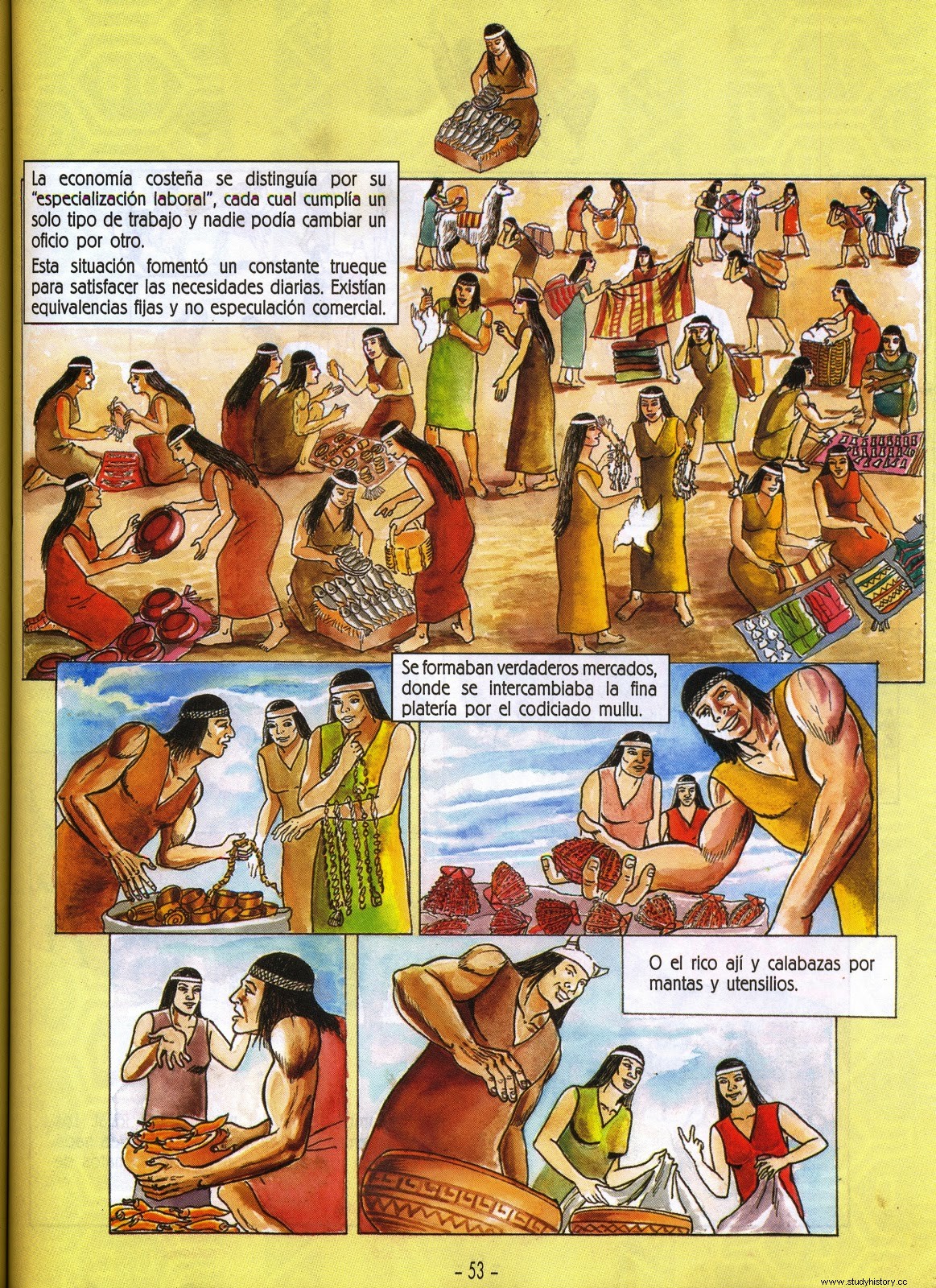 The girls achieved great commercial developmentUrpihuachay she is a deity of the chinchas that is remembered in mythology of Urpiwachaq and the creation of the fish. It says:along the path by the seashore (...) there was a house next to a pond, where a goddess called Urpiwachaq lived, who, curious, went to see what was happening to Cavillqa, leaving her two daughters (beautiful girls) in the care of a snake. Upon his return the god Kuniraya saw them, entered the house (because of his divine quality he became invisible to the snake), and trickily wanted to take them as his wives to the young women, but they became pigeons and they flew away. . Angry, Kuniraya kicked the great pitcher where the goddess kept all the fish (saying by urpiwachay:This woman gives birth to pigeons!) and the pitcher, bouncing, fell into the sea that had just populated with these marine creatures. The Chincha kingdom was a militaristic society after being conquered by the Incas, the Chinchay Cápac maintained its importance during the Inca era. Moreover, it is even said that the only man who could go loaded after the Sapa Inca in the ceremonies, and was present when the Inca Atahualpa was taken prisoner by the Spanish
The girls achieved great commercial developmentUrpihuachay she is a deity of the chinchas that is remembered in mythology of Urpiwachaq and the creation of the fish. It says:along the path by the seashore (...) there was a house next to a pond, where a goddess called Urpiwachaq lived, who, curious, went to see what was happening to Cavillqa, leaving her two daughters (beautiful girls) in the care of a snake. Upon his return the god Kuniraya saw them, entered the house (because of his divine quality he became invisible to the snake), and trickily wanted to take them as his wives to the young women, but they became pigeons and they flew away. . Angry, Kuniraya kicked the great pitcher where the goddess kept all the fish (saying by urpiwachay:This woman gives birth to pigeons!) and the pitcher, bouncing, fell into the sea that had just populated with these marine creatures. The Chincha kingdom was a militaristic society after being conquered by the Incas, the Chinchay Cápac maintained its importance during the Inca era. Moreover, it is even said that the only man who could go loaded after the Sapa Inca in the ceremonies, and was present when the Inca Atahualpa was taken prisoner by the Spanish  .
.CULTURAL ACHIEVEMENTS The chinchas had a mythical-divine ideology. Its main deity was the dove called Urpi Huachay. They were polytheists, they worshiped the stars, the sea and the animals. Among his contributions in architecture we have his monumental constructions that were made with mud, stone, adobe and rammed earth, highlighting Tambo de Mora (capital center), and Lurinchincha. All the constructions and economic production fell on thousands of peasants, fishermen, artisans, prisoners to support the parasitic Chincha nobility. Its constructions are pyramidal structures and canchones made of rammed earth, highlighting two nuclei:the Sentinel of Tambo de Mora –which formed a larger complex with La Cumbe and the huaca Tambo de Mora– and further south the complex of the Sentinel of San Pedro, both in the lower valley. Many of the mounds have friezes in flat relief and mural painting, indicating their importance as ceremonial and residential complexes. Menzel and Rowe call the Sentinel of Tambo de Mora “the capital of the kingdom”, from which several ceremonial radial paths started –as Wallace points out– to unite sites and valleys. To tell the truth, almost all the mounds that make up these architectural complexes have a late Inka occupation, identifiable by small parallelepiped adobe constructions, in contrast to the local constructions made of rammed earth. However, the main Inka occupation is found on the southwestern side of the Sentinel, occupying 2 of the 40 ha that the Tambo de Mora Sentinel must have originally had.
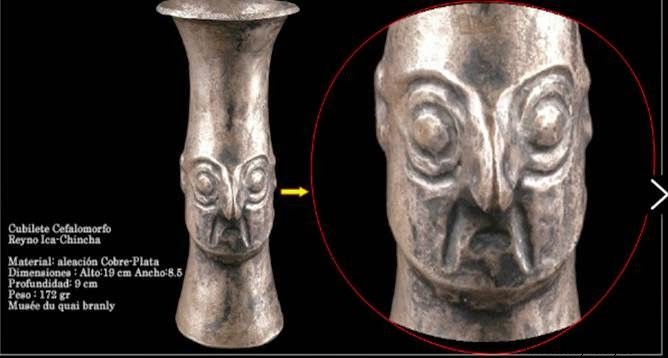 BIG-NOSED GLASSES
BIG-NOSED GLASSES Huaca tambo of blackberry:
It is located in the vicinity of the town of Tambo de Mora, approximately 1km away. The main mound consists of two 20m-high structures with intermediate terraces. There are two other mounds located one to the west or the other to the south. The Huaca de Tambo de Mora covers an area of approx. From 62,500m. Max Uhle assumed that it corresponded to the palace of the great curacas of Chincha.
The summit:
It is a complex located approximately 2 km northwest of Chincha Baja, 1400 m from Tambo de Mora and 800 m from the sea. It is a terraced pyramid, made of adobes and rammed earth, which rises 15 m above the current surface. Max Ulhe considered that it could be the Pre Inca sanctuary of Chinchaycamac, mentioned by the chroniclers. Other smaller structures rise to the west and south of the building.

The Sentinel Huaca
It was a large urban center with ceremonial administrative functions, which was built in the so-called late intermediate period (1100-1350 AD) and later modified during the late horizon (1350-1532) with the annexation of the great Chincha lordship to the Empire. of the Incas of Cusco (approximately 1470 AD).
This archaeological complex is made up of 14 mounds between pyramids and platforms, highlighting among them a large pyramidal structure on the west side, and which many researchers recognize as the Chinchaycamac temple, which in pre-Hispanic times was the main shrine and huaca of the Chinchanos.
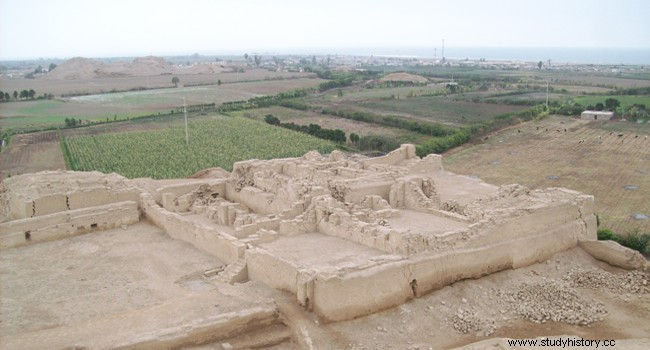
"Walls" It is a technique of building a wall made by a mold or box whose name is "tapias", "the wall is rammed wet earth". It was initially practiced on the central coast during the middle horizon, for example in Cajamarquilla, Pachacamac, Guaycan de Pariachi, Oquendo de Cieneguilla and in almost all the constructions of that time that later spread with the Wari" (Campana-1999).
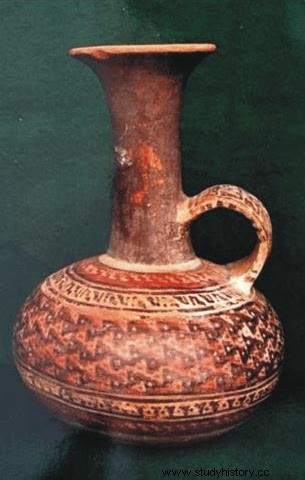 Its ceramics Jars with a globular body and a long neck stood out due to their original shapes, with an intermediate handle that joins them. In their decoration they used geometric motifs inspired by textile art. They produced globular pitchers with short necks and long necks in black, white, cream, red and gray (polychrome). They were all given a small and crowded decoration, true frets made by brush, as well as human, animal and vegetable figures. Among the latter, those of fish, birds and dogs stand out. Shape and decoration is the best thing about this pottery.They made textiles very fine, predominantly in cotton. It shows the great skill of the Chincha weavers, who made the finest fabrics of their time
Its ceramics Jars with a globular body and a long neck stood out due to their original shapes, with an intermediate handle that joins them. In their decoration they used geometric motifs inspired by textile art. They produced globular pitchers with short necks and long necks in black, white, cream, red and gray (polychrome). They were all given a small and crowded decoration, true frets made by brush, as well as human, animal and vegetable figures. Among the latter, those of fish, birds and dogs stand out. Shape and decoration is the best thing about this pottery.They made textiles very fine, predominantly in cotton. It shows the great skill of the Chincha weavers, who made the finest fabrics of their time But where they stood out the most was in wood carving or xylography , as shown in the oars, ceremonial paddles or funerary beams with geometric motifs and representation of birds. These objects were used in commercial exchange. In the illustration you can see the upper part of a ceremonial oar, worked in a neat and detailed way, which presents five mythical characters dressed in different bird headdresses and geometric figures. On the other hand, two forms stand out. truly enigmatic of these wood carvings which are:the long bars with various perforations with an anthropomorphic character at one end and the guarango pitchforks decorated with a rather schematic human face. It is presumed that they were ceremonial poles.
But where they stood out the most was in wood carving or xylography , as shown in the oars, ceremonial paddles or funerary beams with geometric motifs and representation of birds. These objects were used in commercial exchange. In the illustration you can see the upper part of a ceremonial oar, worked in a neat and detailed way, which presents five mythical characters dressed in different bird headdresses and geometric figures. On the other hand, two forms stand out. truly enigmatic of these wood carvings which are:the long bars with various perforations with an anthropomorphic character at one end and the guarango pitchforks decorated with a rather schematic human face. It is presumed that they were ceremonial poles.FINAL It was conquered by the Incas during the reign of the Inca Pachacútec and definitively annexed to the Empire during the government of Túpac Inca Yupanqui, around the year 1476. But it maintained its importance even during the Inca era.
It is said that when Atahualpa Inca arrived in Cajamarca, in a litter of gold, there was another man who also arrived in the same way. After the capture of the Sapa Inca, when Pizarro questioned him, he asked about the lord of the other golden litter and the Inca replied:“…he is the Lord of Chincha, important because he has more than 200 vessels for trade and is the richest. of all my subjects”…(María Rowstorowski)
“THE CHINCHAS, GREAT MERCHANTS ”
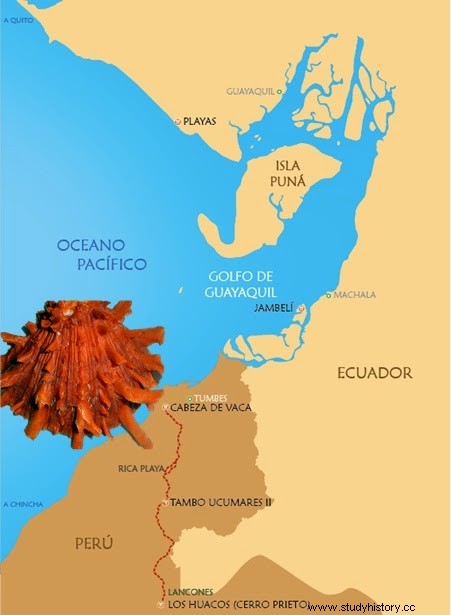 In June 1989 she published the second edition of her book "CostaPeruana Prehispánica" where the historian refers that during the fifteenth century in Chincha there were some 600 merchants who made overland trips using camelids to the Cusco region and the entire Collao with whom they maintained an active trade, bringing them dried fish, pumpkins, mullo from the north coast and exchanging it for silver and gold . By sea they carried their products on totora and tree trunk rafts all along the coast to Mantas and Puerto Viejo in Ecuador, important places for bartering and trade between maritime traffic from the South and from the North. The product they marketed the most was mullo, a mollusk shell whose scientific name is Spondylus. The mullo had a ritual meaning in the Andean area. Trade was based on barter consisting of the exchange of some products for others, carried out by merchants or "indian-style marketing". Around 1450, the Incas, very interested in the Chincha trade networks, especially to control Mullu (Spondylus), decide to conquer them. The first attempts were during the government of the Inca Pachacútec, who sent an army under the command of Captain Cápac Yupanqui, who was unable to break the local defenses. A second attempt under the government of the next Inca, Túpac Yupanqui, achieved its goal. After several years of war, the chinchas reach an agreement to accept being part of the Tawantinsuyude of the Incas in exchange for maintaining part of the control of their old commercial routes. For the Incas, the mullu brought from the north was very important, because it was sacred and necessary in religious ceremonies and copper, the most used utilitarian metal at that time, both products, traded by chincha merchants…. (Maria Rostworowski DiezCanseco)
In June 1989 she published the second edition of her book "CostaPeruana Prehispánica" where the historian refers that during the fifteenth century in Chincha there were some 600 merchants who made overland trips using camelids to the Cusco region and the entire Collao with whom they maintained an active trade, bringing them dried fish, pumpkins, mullo from the north coast and exchanging it for silver and gold . By sea they carried their products on totora and tree trunk rafts all along the coast to Mantas and Puerto Viejo in Ecuador, important places for bartering and trade between maritime traffic from the South and from the North. The product they marketed the most was mullo, a mollusk shell whose scientific name is Spondylus. The mullo had a ritual meaning in the Andean area. Trade was based on barter consisting of the exchange of some products for others, carried out by merchants or "indian-style marketing". Around 1450, the Incas, very interested in the Chincha trade networks, especially to control Mullu (Spondylus), decide to conquer them. The first attempts were during the government of the Inca Pachacútec, who sent an army under the command of Captain Cápac Yupanqui, who was unable to break the local defenses. A second attempt under the government of the next Inca, Túpac Yupanqui, achieved its goal. After several years of war, the chinchas reach an agreement to accept being part of the Tawantinsuyude of the Incas in exchange for maintaining part of the control of their old commercial routes. For the Incas, the mullu brought from the north was very important, because it was sacred and necessary in religious ceremonies and copper, the most used utilitarian metal at that time, both products, traded by chincha merchants…. (Maria Rostworowski DiezCanseco)